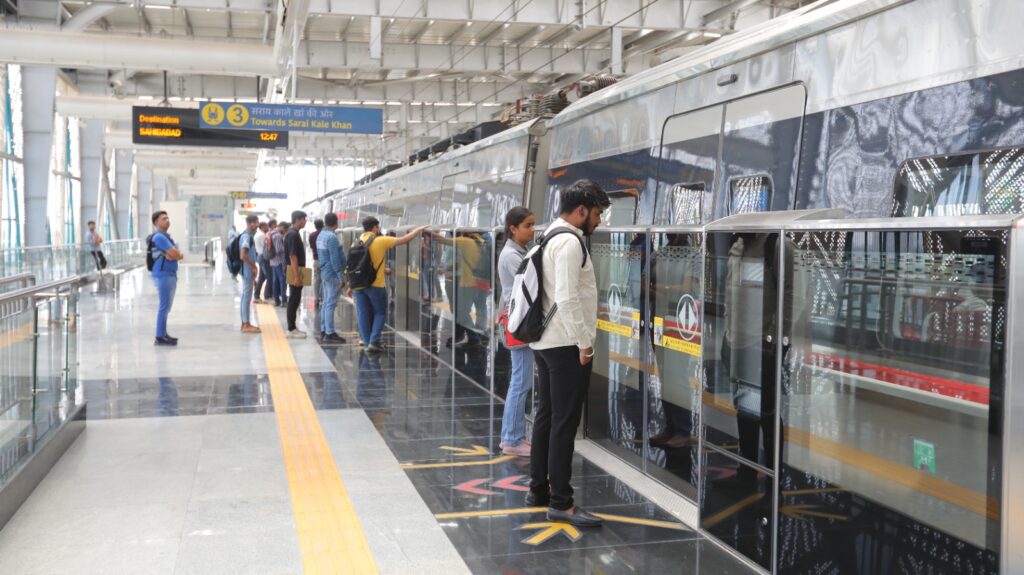 Ghaziabad: The Namo Bharat train service has become a preferred commuting option for college students in areas like Ghaziabad, Duhai, and Modi Nagar, home to numerous educational institutions. Serving as a crucial lifeline, it offers college students residing nearby and along the RRTS corridor a fast, reliable, safe, comfortable and secure commute to their educational institutions. Thousands of students can now travel conveniently and efficiently, thanks to reduced commuting challenges.
Ghaziabad: The Namo Bharat train service has become a preferred commuting option for college students in areas like Ghaziabad, Duhai, and Modi Nagar, home to numerous educational institutions. Serving as a crucial lifeline, it offers college students residing nearby and along the RRTS corridor a fast, reliable, safe, comfortable and secure commute to their educational institutions. Thousands of students can now travel conveniently and efficiently, thanks to reduced commuting challenges.
The operational RRTS section between Sahibabad and Modi Nagar North has numerous educational institutions like engineering colleges and coaching institutes. This section is witnessing a significant influx of students whose preferred mode of transport is now the Namo Bharat Train.
Students, once struggling with the challenges of conventional public transportation like autorickshaws, buses now experience a comfortable and trouble-free commute on Namo Bharat trains. Students are insulated from the dust, grime and heat of conventional public transport.
Additionally, for providing last-mile connectivity, NCRTC has also been engaging with educational institutions along its alignment to rationalise their bus routes. This initiative aims to enable students and staff to use Namo Bharat trains for a portion of their total commute saving time.
NCRTC has been regularly interacting with various educational institutions to raise awareness among students about the Namo Bharat train services and the RRTS Corridor. In these interactions, students are exposed to various themes related to the project, such as technology integration and transit-oriented development. The RRTS is the first of its kind regional rapid rail system in India with a design speed of 180 km/hr and an operational speed of 160 km/hr. These interactive sessions provide invaluable insights into the significance and potential impact of the Namo Bharat trains and RRTS system on the region’s transportation landscape.
Educational Institutions are leveraging their proximity to the RRTS Corridor with progressively less commuting times for their students and staff. Prof. Mohd. Vakil Dean of the RD Engineering College in Duhai, Ghaziabad says that numerous students from our college, many of them hailing from Duhai & Murad Nagar locations have secured placements as loco pilots and ground staff for the RRTS project, reflecting the fruitful partnership between academia and industry. The sight of the RRTS Corridor, a mere 500 metres from our college campus, is a daily inspiration, fueling our students‘ motivation.
Anuj Uniyal a 2nd year BTech CS (Data Science) student of RD Engineering says that his commute from Modinagar to the college has become more comfortable, fast and secure. He says that the security in the RRTS corridor has reduced the chances of theft during the trip which is a positive development.
Kanchan Sharma a 2nd year Btech student CS student of the same college says that she has used the Namo Bharat train to reach her examination centre at Sahibabad. The biggest USP of the RRTS corridor is its reliability and it has helped her avoid traffic jams. The spacious Namo Bharat train and the focus on recruiting women are another feature that appeals to her.
Mr. Virat Raj Saxena, Assistant Professor Raj Kumar Goel Institute of Technology, (RKGIT), Ghaziabad says that travelling on Namo Bharat trains has made life easier for students and staff at the RKGIT. The trains are faster and more efficient, helping everyone be on time and reducing travel time. This means they can get more work done. Also, better connectivity makes it easier to access academic and professional opportunities, helping everyone to grow and develop.
Aditya Singh, a 3rd year CSE student at RKGIT Ghaziabad says that commuting on India’s first & fastest rapid rail – the Namo Bharat train – has been a game-changer for students like myself. The swift and reliable transportation has not only slashed commute time but also alleviated stress associated with travel. This enhanced accessibility has enabled me to explore internship opportunities, attend workshops, and engage in extracurricular activities beyond the campus, enriching my overall college experience.
With the entire Delhi-Ghaziabad-Meerut RRTS corridor gearing up for full operational status soon, students are set to reap even greater benefits. Accessibility to leading universities in the National Capital Territory of Delhi will become easier and remarkably faster. This marks a significant shift in the educational landscape, offering students seamless access to higher education without the burden of lengthy commutes.
The Delhi-Ghaziabad-Meerut RRTS corridor is now poised to be the catalyst for educational transformation. As the lifeline for students, it will stand as a testament to the power of infrastructure in shaping the future of education and enabling seamless access to knowledge hubs for aspiring minds. Construction is advancing swiftly on the remaining sections of the RRTS corridor, and the entire 82 km corridor is anticipated to be operational by 2025.
